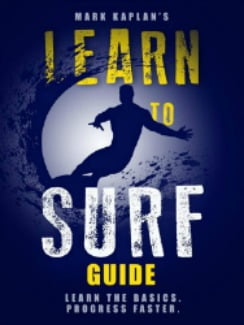Beginner Surfers Learn 5 Fundamentals
Beginner surfers learn 5 fundamentals to begin their journey of advancing. Surfing is more technical than most beginner surfers expect and also more physically demanding than they expected.
The fundamentals are a sequence of steps from spotting a wave to riding it to the beach. It is more about timing than balance. Most beginners have sufficient balance if they learn the sequence and the right posture on the board.
The Beginning
Beginner surfers ride foam waves. They see the real wave break and as the foam wave rolls toward them, they begin paddling for momentum. When the wave is five feet away they start paddling hard as the wave hits the board and until they are in front of the foam.
The beginner surfer then starts the pop up sequence. The pop up sequence for beginners is first to put their hands on the board next to their chests in a man’s push up position. Then with a second’s rest, they push up and put their back foot on the board flat and under their butt.
They stand up on that back foot and raise their hands as they move the front foot to the nose of the board. The correct posture is having the feet shoulder width apart and the hips and shoulders squared to the front. The beginner surfer does not want a shoulder sliding backward like a snowboarder.
If the beginner surfers posture is correct on the surf board, the board will ride straight to the beach and there is no extra work required. If the surfer falls off the butt side of the board, he is riding with an arm back. Both hands should be in front of the surfers face so he can see them.
Advancing to the Next Step
After the beginner surfer has learned the techniques and is riding straight to the beach, he should begin paddling out to ride bigger foam waves and then trying to catch small real waves.
Conditioning and courage will improve with practice. Each step to bigger waves requires confidence that the surfer has mastered the techniques and courage. Bigger waves hit harder and the wipe outs are more noticeable. The beginner surfer sticks with a soft top surf board for at least six months if he is practicing often.
How often a surfer gets to practice, his conditioning, and his ambitions, decide whether he wants to move to shorter or maybe longer surf boards.
Learn More
For Oceanside Surf Lessons, see the Home Page
See the Post Surf Lessons Begin with Foam Waves
See the Post What You Learn in a 2 Hour Lesson
See the Post How to Progress in Surfing
See My Dry Land and In Water Demo video
See How to Catch a Green/Real Wave video
i have lowered my book and course prices for the lock down.
My New Surfing Course in an E-Book plus Demo Video
Get the 18 Chapter, 7,500 word Course that can prepare you for a lesson or give you the fundamentals if you are going to try it on your own. 10 years of teaching 350 students a year has given me the insights on the most precise measures you must follow for success. This course is what I teach on the dry land and in water instruction. The Course includes a 15 minute video on my dry land and in water demonstration. Only $4.95
Buy the E-book for $2.99. Learn to Surf (Different cover but same book)
Buy the Paperback on Amazon $6.95
Get Learn to Surf Course in 29 minute audio. Great prep for a lesson, reviewing after a lesson, learning on your own, refreshing after not having surfed for a while. See Table of Contents. Only $7.95

80 page Learn to Surf Book
![Surf Instructions Beginner to Advanced: Learn to Ride Waves by [Kaplan, Mark]](https://images-na.ssl-images-amazon.com/images/I/51HswFtoBQL.jpg)
Buy my E-book on Amazon Kindle for $2.99. 80 pages of beginner to advanced instructions to help you before the first lesson to learning expert techniques and tricks.
I also have books on Creating Your Own Happiness on a site called Happiness and Work Life Balance